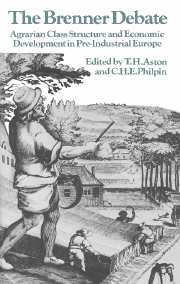Book contents
- Frontmatter
- Contents
- Preface
- Introduction
- 1 Agrarian Class Structure and Economic Development in Pre-Industrial Europe
- 2 Population and Class Relations in Feudal Society
- 3 Agrarian Class Structure and the Development of Capitalism: France and England Compared
- 4 Peasant Organization and Class Conflict in Eastern and Western Germany
- 5 A Reply to Robert Brenner
- 6 Against the Neo-Malthusian Orthodoxy
- 7 A Crisis of Feudalism
- 8 In Search of Agrarian Capitalism
- 9 Agrarian Class Structure and Economic Development in Pre-Industrial Bohemia
- 10 The Agrarian Roots of European Capitalism
- Index
- Past and Present Publications
8 - In Search of Agrarian Capitalism
Published online by Cambridge University Press: 27 October 2009
- Frontmatter
- Contents
- Preface
- Introduction
- 1 Agrarian Class Structure and Economic Development in Pre-Industrial Europe
- 2 Population and Class Relations in Feudal Society
- 3 Agrarian Class Structure and the Development of Capitalism: France and England Compared
- 4 Peasant Organization and Class Conflict in Eastern and Western Germany
- 5 A Reply to Robert Brenner
- 6 Against the Neo-Malthusian Orthodoxy
- 7 A Crisis of Feudalism
- 8 In Search of Agrarian Capitalism
- 9 Agrarian Class Structure and Economic Development in Pre-Industrial Bohemia
- 10 The Agrarian Roots of European Capitalism
- Index
- Past and Present Publications
Summary
In his article “Agrarian Class Structure and Economic Development in Pre-Industrial Europe”, Robert Brenner has addressed himself to major historical problems about agrarian change and the modernization of societies. The effects on peasantries of such processes are of more than historiographical and methodological interest and have political and social reverberations among today's debates about strategies for development. Besides offering a general critique of neo-Malthusian accounts of European social and economic development since the twelfth century, Brenner also joins a long line of expositors beginning with the Physiocrats. These found the essential cause of differences in growth between France and England in differences in agrarian structures and productivity, due mainly to the dominance of large farms in England.
In so far as Brenner's argument suggests that demographic constraints and cycles have often been taken as the main determinants of economic and social developments, or at least have occupied so much attention and exposition as to have left little room for consideration of other factors, I sympathize with him. It has become a favourite axiom of French historians that a population of some twenty millions provided a ceiling in medieval and early modern France beyond which it was impossible to go, given existing agrarian techniques. Braudel believes that this figure around 1600 meant that France was too densely populated and had become “a vast emigration zone”. Yet on his own figures Italy, with a far greater area of mountain, had a population density of forty-four persons to the square kilometre against France's thirty-four. As a quarter or more of France was forest, it is not immediately apparent why the cultivated area could not have been increased, even if agricultural techniques were unchanging.
- Type
- Chapter
- Information
- The Brenner DebateAgrarian Class Structure and Economic Development in Pre-industrial Europe, pp. 138 - 191Publisher: Cambridge University PressPrint publication year: 1985
- 3
- Cited by



